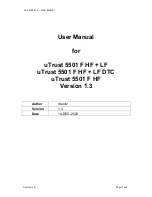
© REA Elektronik GmbH, Teichwiesenstraße 1 D-64367 Muehltal
REA VeriCube Operating Manual Version 2.16 – 11/2020
Page 81 of 119
12.1
Evaluation
The presetting for the evaluation is done in the menu Configure / Evaluation.
The important setting is "selected grade". For this purpose, the desired minimum
quality in the area of the grade Sufficient (Grade 1), Satisfactory (Grade 2), Good
(Grade 3) or Very good (Grade 4) is determined according to the respective test
standard. A measurement result which has achieved, for example, Grade 2 – the
grade Satisfactory, is thus evaluated in the previously selected Grade 1 as "Passed"
and in the selected Grade 3 as "Failed".
The barcode evaluation (1D) permits the choice between the ISO/IEC 15416 and
ANSI X3.182 evaluation (this ANSI standard has subsequently been withdrawn.
The evaluation and the measurement result do not change depending on the setting
of ISO or ANSI. It is just the presentation of the measurement result that changes
from numerical data to letters for the class (A instead of 4, B instead of 3, C instead
of 2, D instead of 1 and F instead of 0). ISO/IEC 15416 is available in the version
from year 2000 (integer grading) and alternatively in the version from 2016
(continuous grading with one decimal).
The matrix code evaluation (2D) permits the choice between the method according
to ISO/IEC 15415 for printed codes, for example on labels, or the DPM method
according to ISO/IEC TR 29158, which is used, for example, for etched codes, dot
peen marking or laser marked on metal (remember DPM software and/or model is
optional).
Note: The standard REA VeriCube has 45 °lighting from all four sides. This
illumination type shall only be modified for DPM codes.















































